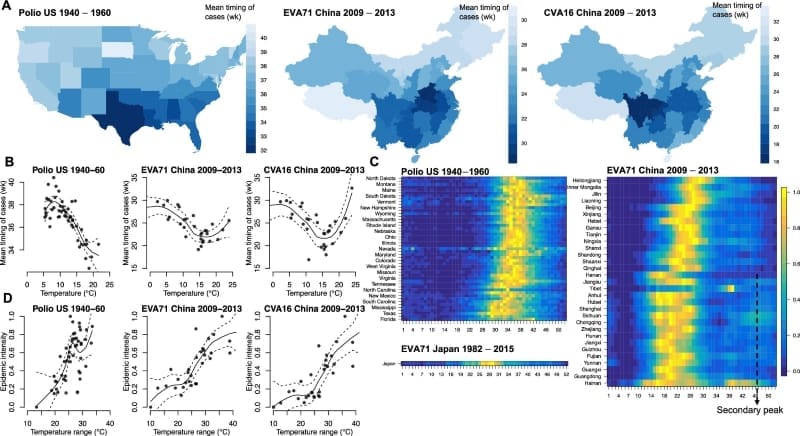Outbreaks of hand, foot and mouth disease (HFMD), which causes fever and rash in young children, typically occur in the summer months. Similarly, historic cases of polio were observed in the summer months in the United States. Both diseases are caused by different species of enteroviruses, a large genus of RNA viruses. However, the drivers of the seasonal patterns of these diseases have remained somewhat unclear.
A common set of drivers can explain the timing of outbreaks of both HFMD and polio according a recent study by researchers at Brown University, Princeton University and Johns Hopkins, published in Nature Communications. Further, these summertime outbreaks may hint at implications for climate change.

“We find, even after controlling for other factors, that temperature appears to increase enterovirus transmission,” said first author Rachel Baker, the John and Elizabeth Irving Family Assistant Professor Climate and Health at Brown University. “Crucially, we see a similar sized effect for polio historically, and more recent enteroviruses serotypes that cause HFMD.”
“Enterovirus outbreaks exhibit clear patterns over space,” noted co-author Saki Takahashi, Assistant Professor of Epidemiology at Johns Hopkins University who has previously studied the outbreak dynamics of enteroviruses in both China and Japan. “At higher latitudes we see large outbreaks of HFMD every two or three years, but closer to the tropics we observe outbreaks twice a year – our results are able to capture these large scale patterns.”
Baker and co-authors used an epidemiological model to show that temperature and demographic drivers, specifically the timing of school semesters, can explain the two HFMD outbreaks a year in southern China. In more northern locations, the temperature effect dominates and the schooling effect disappears.
“What really matters is the seasonal range of climate, i.e. the maximum temperature and minimum temperature,” said co-author Wenchang Yang, Associate Research Scholar of Geosciences at Princeton University. “That might have implications for how we think about the future effects.”
The authors used their model to consider the implications of climate change for enterovirus outbreaks using output from 14 different climate models. “A key finding is the impact of variability,” said co-author Gabriel Vecchi, the Knox Taylor Professor of Geosciences and Director of the High Meadows Environmental Institute at Princeton University. “The impact of climate variability on disease dynamics is underexplored, and this study represents a clear advance in the needed exploration of this topic.”
The authors found that climate change could increase the peak size of enterovirus outbreaks by up to 40%, but effects vary by location and climate model. Improved surveillance of enterovirus circulation could help track these possible impacts: “Serological surveys are vital for tracking susceptibility to enteroviruses and other pathogens,” said Takahashi.
Journal Reference:
Rachel E. Baker, Wenchang Yang, Gabriel A. Vecchi & Saki Takahashi, ‘Increasing intensity of enterovirus outbreaks projected with climate change’, Nature Communications 15, 6466 (2024). DOI: 10.1038/s41467-024-50936-3
Article Source:
Press Release/Material by Brown University
Featured image credit: kjpargeter | Freepik




